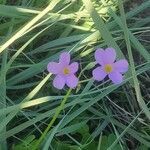Acaulescent bulbous herb with a vertical rhizome 1–10 cm. long.. Bulb solitary at base of rhizome, ovoid-ellipsoid, up to 12 mm. long and 6–12 mm. in diameter, covered by 2 or more dirty brown reticulate scales.. Leaves 3-foliolate, appearing in a rosette at the soil-surface, with petioles widening at the base; leaflets sessile, broadly obovate, cuneate, the middle one usually shallowly emarginate, slightly wider than the lateral ones, 5–11 mm. long and 9–19 mm. wide, and with a distinct midvein, the lateral ones 5–11 mm. long and 5.5–16 mm. wide, with no midvein but with up to 4 veins arising from the base, usually foveolate on both sides, glabrous or rarely ciliate on the midvein below.. Flowers solitary on erect peduncles longer than petioles; bracts 2, linear, l.5–2(–4) mm. long.. Sepals oblong-lanceolate, sometimes with 2 apical calli, 3–4(–5) mm. long, shortly hairy and ciliate at the top, usually tinged purple.. Petals pink or purple, sometimes with a yellow base, narrowly obovate, 10–23 mm. long, entire, hairy in part on the outside.. Filaments glabrous.. Styles densely hairy; flowers can be long-styled (styles longer than both stamen whorls), mid-styled (styles intermediate in length between the 2 stamen whorls) or short-styled (styles shorter than both stamen whorls), but the homostylous condition (styles as long as long filaments) has not been noticed; stigmas laciniate.. Capsule globose, shorter than the sepals, 3–3.5 mm. long, terminated by the persistent styles.. Seeds 1 or 2 in each locule, 1 mm. long, light brown with faint markings.
Perennial herb, up to 200 mm high. Tunics roughly veined. Leaflets broadly obovate, 8-18 x 12-25 mm, often with obscure calli. Flowers: peduncle 1-flowered; sepals ecallose, with apices acute, pilose; petals rosy or rosy-violaceous, rarely white, tube yellow, 14-23 mm long; Nov.-Mar.
Leave 3-foliolate; leaflet-lamina up to 17 × 4 mm., subcircular to very broadly obovate or transversely elliptic, apex rounded to shallowly emarginate, base cuneate or slightly attenuate, glabrous or sparsely pubescent and usually distinctly faveolate; petiole 2–9 cm. long.
A herb. The bulb is about 1 cm long. There are several leaves. They are up to 7 cm long. The leaflets are roundish. They are about 1 cm across. The flowers occur singly on stalks slightly longer than the leaves. The flowers are bright pink. The petals are 2 cm long.
Herb, up to 200 mm tall. Bulb ovoid, not angled or winged. Leaflets as broad as or broader than long. Sepals acute, pilose, without calli. Style and longest stamens not exserted. Ovary ecallose. Flowers rosy or rosy-violaceous, rarely white, with yellow tube.
Acaulescent geophyte, up to 0.15 m high. Bulbs ovoid or globose, often roughly veined. Leaves trifoliolate, leaflets elliptical to cuneate-obovate. Flowers rose or white with yellow tube. Flowering time Dec.-Mar.
Flowers up to 2·5 cm. in diam., pink or mauve, sometimes with a yellow centre, solitary; peduncle up to 9 cm. long.
Acaulescent perennial herb with vertical rhizome up to 10 cm. long (sometimes very short in young plants).
Bulb 8–12 mm. in diam., subglobose or ellipsoid, solitary at the base of the rhizome.
Sepals up to 4–5 × 2–2·2 mm., broadly oblong-elliptic, with or without apical calli.
Filaments with minute glandular hairs (otherwise glabrous).
Petals 10–23 mm. long.

